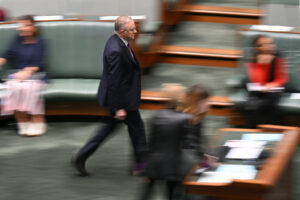It is hard to claim a mandate for something you barely mention, but just as the Turnbull government has stopped talking about the Australian Building and Construction Commission, the business community has now made a TV advertisement for the company tax cuts that, wait for it, doesn’t mention the company tax cuts. It wasn’t meant to be this way.
There was a time that the public took the business community seriously when it talked about what was “good for the economy”, but those days were squandered telling ghost stories about the “devastating wrecking balls” of the carbon and mining taxes. Now that business groups want to tell fairy stories about all of the rainbows and unicorns that will accompany a cut in the company tax cut, are they really surprised that no one is taking them seriously?
The abuse of economic modelling to dress up lobbyists’ interests as being in the national interest is central to the public’s lack to faith in both the government’s, and business communities’ claims about what the economy “needs”. While the modelling that the boosters for the tax cuts have been relying on is based on some dubious assumptions, the main problem isn’t what is assumed, but what is found. Put simply the modelling shows that the long-run benefits of sacrificing $50 billion in company tax revenue are trivial. The “benefits” are more accurately described as rounding error than significant reform.
According to Treasury’s in-house modelling, and the modelling it commissioned from Chris Murphy, if the company tax rate is lowered from 30 per cent to 25 per cent then gross domestic product will double by September 2038, while without the tax cut it won’t double until December 2038. Wow, a whole three months earlier. Both modelling exercises conclude that in 20 years’ time the unemployment rate will be 5 per cent regardless of whether we spend $50 billion on company tax cuts or not.
Writing in these pages last week a number of business lobbyists suggested that critics of their preferred tax cuts were comparing “apples with oranges” by comparing the $50 billion up-front cost of the cuts to the tiny increase in GDP in two decades. It was, they argued, disingenuous to compare the “one-off” cost of $50 billion with the “permanent” benefit of trivially higher levels of economic activity.
The problem with this argument is that it is completely wrong. The $50 billion cost of the cut in the company tax rate is not a “one-off investment”, on the contrary, it is merely the lost revenue for the first 10 years. Over 20 years the cut in the company tax rate will cost around $300 billion and, by 2036, it will be costing around $30 billion per year, growing in perpetuity.
It is not clear whether the business lobbyists can’t tell their own “apples from oranges” or whether they were simply hoping that no one would notice that it was they who were misrepresenting the modelling results that so many people discuss and that so few people have read.
But what is clear is that the public will no longer simply accept the claims that business lobby groups make about the economy. Whyalla was not “wiped out” by the carbon price. But now that is in danger of being wiped out by imported steel, business groups that once feigned concern for steel workers have gone strategically silent. Business lobbyists that once claimed that the impact of the carbon price on the wholesale price of gas would “devastate” manufacturing sat in silence as gas export deals drove gas prices far higher than the carbon tax ever would have.
Even if the Coalition wins next month’s election the fate of the corporate tax cuts will ultimately be determined in the Senate. Indeed, Mr Turnbull is at pains to highlight to voters that the corporate tax cuts he claims are so important to create “jobs and growth” are at least two election cycles away. Some have accused the Turnbull government of crab walking away from the promise to legislate the full corporate tax cuts in its next term. When even the business lobbyists don’t want to mention them in their own ads, Mr Turnbull’s growing ambivalence makes sense.
First published in the Australian Financial Review – here.
Related documents
Between the Lines Newsletter
The biggest stories and the best analysis from the team at the Australia Institute, delivered to your inbox every fortnight.
You might also like
Sorry BCA – the data shows businesses like investing in Victoria
Despite what the Business Council of Australia would wish you to believe, Victoria is one of the most popular places to invest in Australia.
Fighting for Facts | Between the Lines
The Wrap with Amy Remeikis Truth and trust can be funny things. Holding someone’s trust means people believe what you say to be true. Speaking the truth consistently wins people’s trust. But trust isn’t always treated with the deference it should be. Too often it can be abused, with truth usually the first to pay
‘Perfect storm’: Government’s lies and half-truths burn through our precious trust
Northern Ireland political philosopher Onora O’Neill gave a series of lectures on “trust” in 2002, where she observed it is one of the most important social constructs we can hold:


